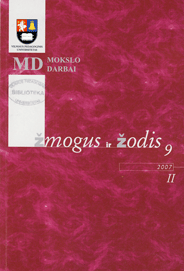Poetikos mokslas ir baroko estetinės idėjos: Sarbievijaus traktato „Apie aštrų ir šmaikštų stilių" novatoriškumas
Poesy Art Theory and Aestetical Ideas of the Baroque: Innovations ofa Treatise "On the Acute and Quickfire Style" by Sarbievius
Author(s): Živilė NedzinskaitėSubject(s): Literary Texts
Published by: Vytauto Didžiojo Universitetas
Keywords: Baroque; poetics; rhetorics; theory of conceptus
Summary/Abstract: The article reviews, how poetics and rhetorics, which were the disciplines most cultivated by Jesuits, reflected changes of social life, literature and culture as well as of human mentality during the 17th century. The treatise "On the acute and quickfire style" which had never been published as a print book but spread eventually in manuscript copies as a useful university manual, is dedicated to analysis of conceptus, one of the most significant concepts of the Baroque poetics. Basing on examples of the Antique and contemporary poesy, Sarbievius was the first to define the already existing then but not yet named or analyzed by theoreticians style of Baroque. The famous formula of his definition, known as concors discordia or as discors concordia (the concordant disagreement or the discordant agreement respectively) was later used not in the theory of literature only but also in the theories of other arts. Thus the treatise by Sarbievius entered the whole-European discussions on literature and culture, held during the 17th centure, becoming one of the earliest works, that gave analysis of the theory of conceptus.
Journal: Žmogus ir žodis
- Issue Year: 09/2007
- Issue No: 2
- Page Range: 83-89
- Page Count: 7
- Language: Lithuanian

